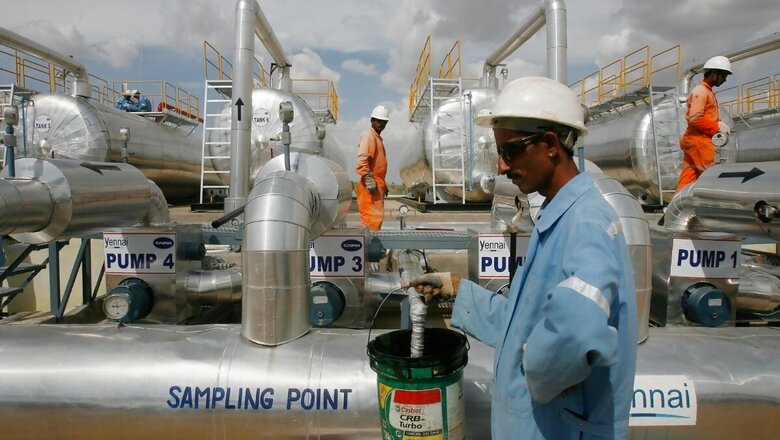
views
India’s energy demand will increase more than that of any other country over the next two decades, the International Energy Agency (IEA) said on Tuesday forecasting India overtaking the European Union as the world’s third-largest energy consumer by 2030. An expanding economy, population, urbanisation and industrialisation will result in India’s energy needs growing at three times the global average under today’s policies, according to IEA’s India Energy Outlook 2021.
“India has arrived at the centre of the world energy stage,” said Fatih Birol, the IEA’s executive director. Energy use has doubled since 2000, with most of that demand met by coal and oil. This is set to grow about 35 per cent until 2030, down from 50 per cent before the coronavirus pandemic.
India will see the addition of 13 new Mumbais in urban population, boosting demand for cement, steel, electricity, he said. Birol said policymakers needed to ensure the next wave of growth is met with renewable energy sources such as solar.
IEA saw primary energy consumption almost doubling to 1,123 million tonnes of oil equivalent as the Gross Domestic Product (GDP) expands to USD 8.6 trillion by 2040. India at present is the fourth-largest global energy consumer behind China, the United States and the European Union.
Underpinned by “a rate of GDP growth that adds the equivalent of another Japan to the world economy by 2040”, India will overtake the European Union by 2030 to move up to the third position, it said in the report. India accounts for nearly one-quarter of global energy demand growth from 2019-40 — the largest for any country. Its share in the growth in renewable energy is the second-largest in the world, after China, IEA said.
“power system is bigger than that of the European Union, and is the world’s third-largest in terms of electricity generation; it also has 30 per cent more installed renewables capacity than the United States,” it said. A five-fold increase in per capita car ownership will result in India leading the oil demand growth in the world. Also, it will become the fastest-growing market for natural gas, with demand more than tripling by 2040.
“India’s continued industrialisation becomes a major driving force for the global energy economy. Over the last three decades, India accounted for about 10 per cent of world growth in industrial value-added (in PPP terms),” the report said. is set to account for almost 20 per cent of global growth in industrial value-added, and to lead global growth in industrial final energy consumption, especially in steelmaking. The nation accounts for nearly one-third of global industrial energy demand growth to 2040.
India’s oil demand is seen rising by rise by 74 per cent to 8.7 million barrels per day by 2040 under the existing policies scenario. The natural gas requirement is projected to more than triple to 201 billion cubic meters and coal demand is seen rising to 772 million tonnes in 2040 from the current 590. To meet its energy needs, India will be more reliant on fossil fuel imports as its domestic oil and gas production stagnates.
Its net dependence on oil imports — taking into account both the import of crude oil and the export of oil products — increases to more than 90 per cent by 2040 from the current 75 per cent as domestic consumption rises much more than production, the report said. Natural gas import dependency increased from 20 per cent in 2010 to almost 50 per cent in 2019 and is set to grow further to more than 60 per cent in 2040.
“The dynamics look quite different for coal, where India’s demand for imported coal barely gets back to pre-crisis levels over the next decade,” IEA said. India currently accounts for 16 per cent of the global coal trade and many global coal suppliers were counting on growth in India to underpin planned export-oriented mining investments.
“These expectations are now running up against India’s determination to boost domestic production, leaving relative certainty only over India’s requirement to import coking coal for its rising steel production, together with steam coal for those coastal power generation plants that have been designed to receive imported grades,” it said. IEA has forecast combined import bill for fossil fuels tripling over the next two decades.
“Energy use (in India) has doubled since 2000, with 80 per cent of demand still being met by coal, oil and solid biomass,” it said. On a per-capita basis, India’s energy use and emissions are less than half the world average, as are other key indicators such as vehicle ownership, steel and cement output.
“As India recovers from a COVID-induced slump in 2020, it is re-entering a very dynamic period in its energy development. Over the coming years, millions of Indian households are set to buy new appliances, air conditioning units and vehicles,” it said. India will soon become the world’s most populous country, adding the equivalent of a city the size of Los Angeles to its urban population each year.
“To meet growth in electricity demand over the next twenty years, India will need to add a power system the size of the European Union to what it has now,” it said. Prior to the global pandemic, India’s energy demand was projected to increase by almost 50 per cent between 2019 and 2030, but growth over this period is now closer to 35 per cent.
“An expanding economy, population, urbanisation and industrialisation mean that India sees the largest increase in energy demand of any country,” IEA said.
Read all the Latest News, Breaking News and Coronavirus News here

















Comments
0 comment